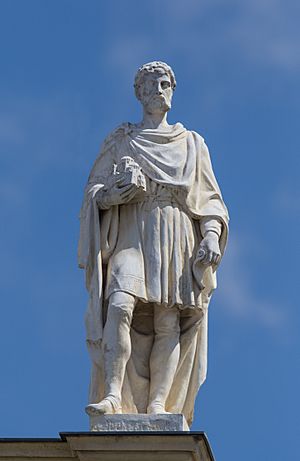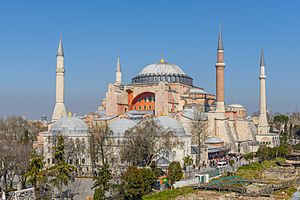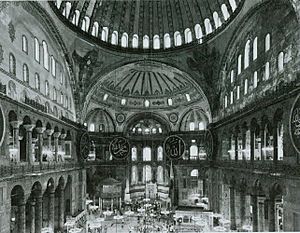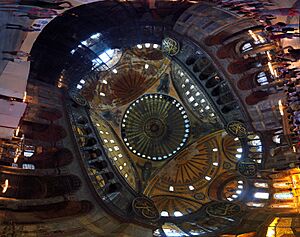Isidore of Miletus facts for kids
Isidore of Miletus was a brilliant Byzantine Greek mathematician, physicist, and architect. He lived around the year 475 AD. Emperor Justinian I chose him and another architect, Anthemius of Tralles, to design the famous Hagia Sophia cathedral in Constantinople. This amazing building was constructed between 532 and 537 AD.
Isidore is also known for putting together an important collection of the works of the ancient Greek mathematician Archimedes. He also helped edit parts of Book XV of Euclid's Elements, a famous geometry book.

Contents
Isidore's Early Life and Studies
Before Emperor Justinian I hired him, Isidore of Miletus was already a well-known scientist and mathematician. He taught about stereometry (the study of 3D shapes) and physics at universities. First, he taught in Alexandria, and later in Constantinople.
Isidore also wrote notes on an older book about how to build vaults. He worked with another scholar named Eutocius to study the writings of Archimedes. Isidore is famous for creating the first complete collection of Archimedes' works, which is known today as the Archimedes palimpsest.
Isidore's Teaching and Writings
Most of Isidore's work that we still have today are his edits and notes on older Greek math texts. For example, he checked and revised some of Archimedes' writings and also Book XV of Euclid's Elements.
A historian named Alan Cameron suggested there might have been a "School of Isidore." Even though Isidore was busy with building projects, he taught a lot about math and geometry. We know about his teaching because his students, like Eutocius, often mentioned his ideas in their own works.
One editor of Euclid's Elements wrote that Isidore didn't publish much of his own work. Instead, he preferred to teach. Once he understood something well, he didn't feel the need to write it down. Because of this, Cameron believes Isidore helped bring back interest in ancient mathematicians in Constantinople and Alexandria around 510 AD.
Besides editing others' works, Isidore wrote his own notes on a book called "On Vaulting" by Hero of Alexandria. This book talked about how to build and design vaults using geometry. Even though Isidore's notes are lost, Eutocius mentioned them in his writings. Eutocius also said that Isidore invented a special compass to draw parabolas. This compass could draw parabolas much more accurately than older methods.
One important use for Isidore's invention was to solve a famous math problem: doubling the volume of a cube. This could be done by drawing two parabolas and finding where they crossed. Isidore also showed how parabolas could be used in building vaults.
Building the Hagia Sophia

Emperor Justinian I decided to rebuild the Hagia Sophia after a big protest in Constantinople, the capital city of the Roman Empire. The first church was built in 360 AD and fixed up between 404 and 415 AD. But in 532 AD, it was badly damaged during the Nika riots. Many buildings, including the church, were burned down.
During the Nika Riot, people who supported different chariot racing teams at the Hippodrome often fought. Many people lost their lives in these riots. Emperor Justinian I wanted to make sure his new church would not burn down again. So, he asked Isidore and Anthemius to build it mostly out of stone and mortar, not wood.
Construction of the Hagia Sophia started very quickly after the riots ended. Some people think Justinian had his architects planning the church even before the fighting stopped.
Isidore of Miletus and Anthemius of Tralles planned for the main hall of the Hagia Sophia to be about 70 by 75 meters (230 x 250 feet). This would make it the largest church in Constantinople. The original dome was planned to be about 6 meters (20 feet) lower than it was actually built. The new Hagia Sophia, built from 532 to 537 AD, was one of the biggest, most beautiful, and most expensive buildings ever.
Even though Isidore and Anthemius were not formally trained as architects, they were scientists. They were able to manage thousands of workers and bring huge amounts of rare raw materials from all over the Roman Empire. They got stone from places as far away as Egypt, Syria, and Libya, and columns from temples in Rome.
The finished building was truly amazing. All its parts fit together perfectly, creating a beautiful and remarkable harmony. It is believed that Isidore did a lot of the work on the domes of the Hagia Sophia because of his deep knowledge of vaults and his writings on the subject.
The architects of the Hagia Sophia cleverly combined the long shape of a Roman basilica with the central design of a dome supported by a round base. This design helped the building stand strong against the frequent and powerful earthquakes in the Marmara Region. However, in May 558 AD, about 20 years after the church was finished, parts of the central dome and its supports collapsed after earthquakes in 553 and 557 AD.
The Hagia Sophia was cracked by earthquakes many times but was always quickly repaired. Isidore of Miletus' nephew, Isidore the Younger, designed the new dome that you can see in the Hagia Sophia today in Istanbul, Turkey. The first dome was built without ribs, but Isidore the Younger added ribs when he repaired the church.
After a big earthquake in 989 AD damaged the dome again, Byzantine officials asked Trdat the Architect to help with repairs. The restored dome was finished by 994 AD.
Images for kids
See also
 In Spanish: Isidoro de Mileto para niños
In Spanish: Isidoro de Mileto para niños




